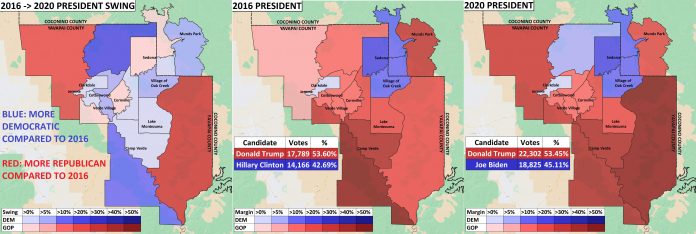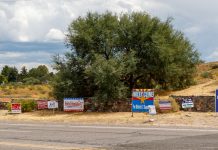On Nov. 3, 2020, former Vice President Joe Biden won the state of Arizona’s 11 Electoral College votes, making him the first Democrat to win the Grand Canyon State since Bill Clinton in 1996.
Biden’s victory came with massive increases in turnout among both Democrats and Republicans since 2016 — Biden won 1,672,143 votes compared to 1,161,167 votes for Hillary Clinton in 2016, while President Donald Trump received 1,661,686 votes, compared to 1,252,401 votes four years before. Democrats managed to improve their vote total by 44%, while Republicans only improved theirs by 32.7%, allowing Democrats to take the state.
“The Native American vote was a key factor,” J. Miles Coleman, an elections analyst at the University of Virginia, wrote in an email describing how Biden won the state. “Biden’s campaign made serious investments in [get-out-the-vote] efforts with Native voters, and I think it paid off.
“While Biden struggled to match Clinton’s numbers with Hispanics in Texas and Florida, the slippage was more limited in Arizona. Biden didn’t make huge inroads with seniors/retirees, but he nibbled away a few points off Trump’s margins in places like Sun City. Put all that together, and it was a close Biden win.”
In the Verde Valley, Trump handily won most of the areas in both elections, as Republicans often do in the rural, conservative-leaning parts of the state. However, looking at the precinct-level data, the seeds of Biden’s over-performance that won him the state can be seen.
In 2016, Trump won the Verde Valley by a 12-point margin, while in 2020, he won it by just 9 points.
From 2016, Democrats did not appear to flip a significantly high number of voters away from Trump. In every precinct except one — the large rural area west of Sedona, which had just 65 total votes in 2020 — the president received more votes than he did four years ago.
In only three precincts — Oak Creek Canyon, the Village of Oak Creek and the mostly empty wilderness area west of Sedona — did the president receive a lower percent of the vote than he did four years before.
What Democrats did manage to do was increase vote totals, mostly from people who either did not vote or voted third party in 2016.
The total number of votes in the Verde Valley in 2016 for a candidate that was not from one of the two major parties was 2,397, compared to just 610 in 2020. Democrats managed to take up a portion of that vote, going from 41.2% of the Verde Valley in 2016 to 45.1% in 2020.
Even as Trump increased his percentage of the vote from 51.8% to 53.4%, his margin of victory over his opponent in the area shrunk, as Biden consolidated the vote of voters who previously voted against Trump but not for Clinton.
Sedona and the Village of Oak Creek each voted for Democrats in both 2016 and 2020. But while that margin of victory increased over the four years in the Village, it did not in Sedona. In the Village of Oak Creek, a 52.4% to 41.9% win [2,205 votes to 1,762] for Democrats expanded to 57.4% to 41.4% [2,789 votes to 2,010].
In Sedona, with voting precincts that include Oak Creek Canyon, as well as the rural area west of town, Democrats went from 3,894 votes to 4,711, while Republicans increased from 2,510 to 3,085. Democrats increased their margin in raw votes, while keeping the percent margin similar — from 56.8% to 36.6% in 2016 to 59.8% to 39.1% in 2020.
Clarkdale-Jerome was the only other area to vote for Democrats both times, going from a 46.1% to 45% margin in 2016 [909 votes to 888] to a 51.6% to 46.7% [1,271 votes to 1,152] margin in 2020.
In the rest of the Verde Valley, which voted for the president just as it had in 2016, there were shifts toward Democrats compared to four years before.
Cottonwood went from a 55.4% to 36.8% margin in favor of the president to a 56.2% to 42.1% margin, with Democrats increasing from 4,209 votes to 5,913 and Republicans increasing by a slightly smaller amount from 6,347 to 7,895.
Camp Verde went from a 68.9% to 25.1% margin [3,428 votes to 1,246] to a 69.8% to 28.8% [4,450 votes to 1,835] margin in 2020.
Rimrock and Lake Montezuma collectively went from 61.3% to 32.3% in favor of Republicans in 2016 [1,304 votes to 687] to 63.2% to 35.1% in favor of Republicans [1,675 votes to 931] in 2020.
Cornville and Page Springs together went from 54.9% to 36.4% for Republicans in 2016 [2,884 votes to 1,914] to 55.9% to 42.4% for Republicans in 2020 [3,516 votes to 2,668].






















